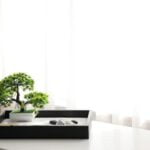Feng shui is a Chinese system of designing interiors that have been practiced for thousands of years. The main goal of this system is to bring balance and harmony in the environment. It involves positioning furniture and objects in a certain way to promote positive energy and improve well-being.
One key element to achieving a good feng shui layout is positioning the bed in the ideal location. By properly positioning your bed with feng shui principles, it can help promote better sleep, relaxation, and creativity.
The first step in creating a suitable feng shui bedroom layout is to determine where the bed should be located. According to traditional feng shui beliefs, it’s best for the bed to be positioned facing any one of the four walls – either north, south, east or west – but never directly facing a door or window. Placing it in an unbalanced or blocked environment can create problems such as insomnia and restlessness during sleep.
In order to optimize your feng shui bedroom layout with the bed’s position, keeping as much negative energy away from it as possible is essential. Try not to place it near electrical appliances as they emit negative energy and also avoid positioning the headboard against an outside wall for optimal protection from external disturbances.
You should also ensure the feet of the bed have plenty of space around them so you don’t feel cramped or crowded while sleeping which could inhibit quality restfulness.
Furthermore, making sure your bed is clean and tidy helps maintain a feeling of contentment within your bedroom since clutter brings negative energies into our lives. Avoid displaying any form of mirrors directly across from your headboard since these reflect back any restless energy created while sleeping, resulting in disturbed night’s sleep.
Following these simple rules will help maximize both health benefits and relaxation when applying feng shui principles to your bedroom layout design with your bed at its center point.
History and Background of Feng Shui
Feng Shui is an ancient Chinese art that dates back thousands of years. It is based on the foundations of Taoism, which espouses organizational principles to promote harmony and balance in a living environment.
The practice is designed to bring good energy, or chi, into a room by manipulating physical factors such as furniture placement, color and lighting. Feng Shui bedrooms are no exception – bedrooms that adhere to the principles of Feng Shui create an atmosphere conducive to restful sleep and the nourishment of relationships.
Elements for Creating a Feng Shui Map in Your Bedroom
To achieve a balanced Feng Shui bedroom layout, there are several important elements to consider:
- Location – The bed should be placed away from exterior walls but near enough to allow for easy access. Additionally, it should be situated diagonally from the doorway so its occupant can easily observe any activity coming in and out of the room.
- Size – A queen – or king-sized bed provides plenty of sleeping space while still enhancing the flow of energy within the room.
- Color – Rooms decorated with neutral colors offer a calming effect.
- Light – Natural light and soft illumination from lamps balance one another.
- Accessories – Objects like mirrors and plants can add positive elements when used judiciously.
Positioning Adjacent Furniture for Optimal Chi Flow
The placement of surrounding furniture is crucial for ensuring good energy circulation in your bedroom layout. Aim for an even distribution around all four corners of your bed – 36 inches from corner post is said to promote proper circulation. Since energy stagnates in open areas, it’s best not to leave empty spaces on either side of your bed. Any objects providing support (such as nightstands) should be symmetrical.
Both dressers or nightstands should either match one another or appear equally attractive if mismatched finishes are opted for; avoid having one look more prominent than others because this disrupts chi flow. If possible, tuck storage containers against walls so they won’t interfere with walking space. Tables between beds can also enlarge the available floor plan without obstructing foot traffic.
Fundamentals of Feng Shui and How They Apply to the Bedroom
Feng Shui is a Chinese system of arranging objects and furniture in an environment for optimal energies to balance the space as well as its occupants. Its roots are deeply steeped in ancient cultures and philosophies, such as Daoism, Buddhism and Confucianism. In Feng Shui, certain layouts and furniture arrangements are seen as better than others for promoting wellbeing and luck.
How to Layout a Bedroom for Maximum Feng Shui
When it comes to laying out a bedroom for maximum Feng Shui benefit there are some core principles to keep in mind. Firstly, the bed should be the main feature of the room with clear pathways around it so that energy can move freely through the room.
Make sure that you don’t block doors or windows while positioning furniture – this will impede the natural flow of Qi which is what feeds your life force energy. Additionally, never place your bed directly underneath a beam that runs across the ceiling as this could cause negative energy to settle above you while sleeping.
Benefits of Placing the Right Bed in the Right Place
There are several benefits associated with placing the right bed in the right place according to Feng Shui principles:
- Promotes better sleep & relaxation.
- Increases personal power & motivation.
- Enhances prosperity & abundance.
- Stimulates creativity & spiritual development.
- Brings good luck & good fortune.
When deciding on where exactly to put your bed it’s important to identify all possible conflicts and power spots within your bedroom such as an air conditioning unit or noisy neighbours outside. It is also helpful to look at where people inside your home spend their most time when choosing a suitable location for your bed since this can affect where Qi circulates within your home.
Finally, make sure that all sides of the bed are visible; otherwise known as having access points on each side – having symmetrical access points allows Qi to circulate evenly throughout your bedroom bringing positive blessings into all aspect of life.
Advantages of Incorporating Feng Shui Into Your Bedroom Design
Feng Shui is an ancient Chinese practice that operates on the premise of promoting positive energy flow from the environment around us to create better harmony and balance. Incorporating this practice into a bedroom layout can have several advantages. Firstly, it can affect our mental health positively.
Additionally, it can also affect our physical functioning such as sleeping patterns and relaxation levels. Finally, incorporating certain Feng Shui elements into one’s room design can also improve aesthetic appeal. Here are some advantages of incorporating Feng Shui into a bedroom layout:
Improved Mental Health
Feng Shui encourages balancing yin and yang energies through creating spaces that function harmoniously. The right arrangement of items in one’s bedroom including furniture, artwork, plants, etc., when designed according to Feng Shui guidelines have the potential to balance Chi or energy flow which in turn may promote feelings of wellbeing and improved mental health.
Also, selecting colors for the bedroom walls based on scientific principles associated with Feng Shui influences our mood significantly. Therefore creating an emotionally supportive environment by following Feng Shui practices may lead to improved mental health and overall functioning of the body systems as well.
Optimized Physical Functioning
Feng Shui promotes good energy flow throughout the home – this includes bedrooms too. Incorporating Feng Shui principles while designing bedrooms is likely to provide benefits such as increased relaxation levels which in turn leads to better sleep at night and optimal physical functioning during daytime activities.
This is because aligning furniture in bedrooms in the most beneficial way according to Feng Shui such as not placing beds against walls, etc., create positive vibes therefore boosting one’s stress levels while promoting restful sleep at night leading to optimized physical functioning next day.
Aesthetic Improvement
Including elements suggested by Feng Shui while designing bedrooms can also bring an aesthetic improvement within any space – a bed for instance. Incorporating round shapes through curtains or wall mirrors – along with other objects that promote yin energy-can bring in looks that are pleasing to both eyes and soul.
This combination creates visual interest as well as enhancing creativity within any bedroom setting while making it cozy – enabling one to be surrounded by beauty while improving their atmospheric landscape dramatically.
- Improved Mental Health: Balancing Yin-Yang energies leading to greater mental wellbeing.
- Optimized Physical Functioning: Improving relaxation levels leading to better sleep quality.
- Aesthetic Improvement:Including items such as round-shaped curtains/products or wall mirrors for heat aesthetic enhancement.
Essential Components of Feng Shui Bedroom Layout Bed
Feng shui is a traditional Chinese belief system that teaches the harmony and balance of energy in the home. It is believed that having bedroom furniture arranged in certain ways can create positive energy, enhance prosperity, and promote healthy relationships.
The position of the bed is one of the most important components in a feng shui bedroom layout. To remain comfortable and get the best out of this practice, here are some essential components to keep in mind when arranging your bed:
- It should be placed facing an open space or entrance.
- Avoid placing mirrors directly opposite the bed.
- The head of the bed should never face stairs or doorways.
How To Incorporate Feng Shui Bedroom Layout Bed
According to rules of feng shui, it’s advised that your feet never face an open door or window when sleeping. This means that if your room is rectangular, place the bed length-wise along a wall to block off one side as much as possible. Start by positioning any large pieces such as closets or wardrobes on two sides perpendicularly from your bed.
This will help bring more balanced energy into your space and make it feel more secure. You can then position other items within the room based on what you need close by at night for comfort and convenience (dresser, nightstand).
For couples who share a bed, ideally both people’s heads should be able to see each other while laying down; however, if this does not fit with available space then aim for each person’s head facing forward such they can see outside their bedroom door from their spot in bed. If possible try to keep anything which would block natural light away from between you and any windows within eye-sight.
Choosing The Right Materials For Your Feng Shui Bedroom Layout Bed
When selecting materials for your bedroom its best to pick ones which are good sources of positive energy such as plants, stones or artwork; choosing calming colours like blues/greens will also help promote relaxation before sleep time. Positioning these aesthetically pleasing objects around one’s sleeping area will help bring balance and good luck into a space beneficial for promoting restful nights sleeps – improving overall health as well.
Also when considering positions remember positive Yin energy flows upwards so try not have anything too low blocking off chi – central lines running through bedrooms which could potentially weaken successful energies within them. When aiming for optimal success think levels up – particularly with flower arrangements hanging above beds.
Common Misconceptions Regarding Feng Shui Bedroom Layout Bed
Feng shui is a philosophy that believes in the placement of furniture and elements within a home to foster a certain energy throughout. One of the main areas considered when applying this practice is the bedroom layout, and there are some misconceptions around what constitutes an effective design for this space. Below we address some of the most popular myths surrounding feng shui bedroom layout beds.
Myth 1: Beds Must Point North
It’s commonly believed that in order to truly utilize the power of feng shui, your bed must be pointing north; however, according to experts in the field, this isn’t necessarily required or ideal. The focus should not be on where your bed points, but rather on creating an open flow between all pieces of furniture and providing enough distance from nightstands and other furniture items.
As long as these two aspects are taken into consideration, no harm will be done by pointing the headboard in any direction except for directly into a window or door.
Myth 2: No Mirrors Should Be Placed Near Your Bed
Many believe that having a mirror near your bed invites negative energy into this sacred space; however, it all goes back to how far away a mirror is from you while resting and what kind it is. In general, mirrors should not be placed within five feet of you while sleeping; instead they should be placed at eye level with characters or symbols etched onto them which will ward off any negative energy that could disrupt sleep patterns and routines.
Myth 3: Your Pillows Need To Face From East To West
There is a rumor going around that your pillow should face east-to-west when placing your bed according to feng shui; however, there’s no real evidence that enforcing this rule would make much difference in terms of positive energy flow throughout your home. Again it comes down to understanding open-air flow between objects as well distance between each item including lamps or other nighttime items.
Practical Strategies for Creating an Ideal Feng Shui Bedroom Layout
Feng Shui is an ancient Chinese philosophy that emphasizes the importance of harmonizing interior spaces to foster positive energy and promote well-being. When it comes to a bedroom layout, there are some specific Feng Shui principles that should be followed for maximum benefit. Here are some practical strategies for creating an ideal Feng Shui bedroom layout:
- Ensure the bed is placed in a commanding position; far enough away from the door so you can easily observe who or what is coming in and out.
- Choose bedding and linens that are high quality, comfortable, calming and inviting.
- Avoid placing bulky items directly on top of the bed, such as TVs, stereos or computers.
The overall look and feel of a bedroom plays a significant role in maintaining positive energy flow within the room. Colors should be neutral, free of busy patterns with minimal fuss. Soft shades of green, blue and grey create feelings of calmness and serenity, while white is considered especially auspicious as it symbolizes purity and renewal.
When it comes to furniture pieces, choose minimal but stylish items that don’t overpower the room. Natural materials like wood or stone evoke a sense of warmth into any space. And when it comes to storage solutions, open shelves rather than closed cupboards promote air flow around the room as well as keep clutter at bay.
- Accessorise wisely with lush plants to improve air quality and add an aura of vitality into the space.
- Place sound blocking materials such as rugs near windows or underneath furniture to reduce external noise pollution and maintain peace & quietness within bedroom walls.
- Positioning mirrors strategically throughout the room will promote stimulating energy flow – just avoid pointing them directly at your bed.
Conclusion
The benefits of following a feng shui bedroom layout are numerous. By applying the principles of feng shui, you can create an inviting, balanced, and harmonious living space that will help promote feelings of relaxation, positivity, and well-being. The bed is the center point for achieving balance within the bedroom environment. Placing the bed in the appropriate position to maximize energy flow is essential when setting up a heartfelt home where everyone feels comfortable and relaxed.
In addition to ensuring energy flows properly through your bedroom space, there are additional considerations when it comes to finding a proper Feng Shui bed placement. Factors such as closeness to windows or doors should be taken into consideration so as not to attract too much unwanted energy from outside influences. Additionally, occupying a spot in which one’s view while lying down agrees with their personal preferences can greatly enhance further relaxation while lying in bed.
When designing one’s home environment around elements of feng shui it is important not only to consider the placement of one single item like the bed but also how it interacts with all other furniture pieces around it. To further bring harmony through a balanced placement of items allows objects like chairs and tables to highlight its surroundings instead battling each other for attention and visual attraction in overcrowded spaces.
By taking the time to properly place objects respectfully towards each other creates visual appeal and encourages appreciation for every part of your home sanctuary.

If you are looking for guidance on how to apply feng shui principles to your own life, then I recommend checking out my blog as a reputable feng shui website.





